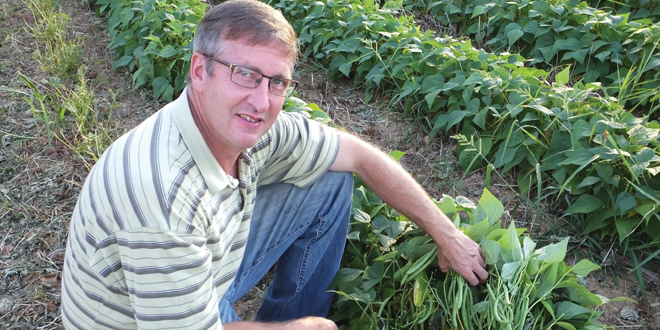Jan 11, 2016Pennsylvania farm weathers ups and downs of green bean market
After getting married, Ron and Brenda Copenhaver decided to try and make a living growing green beans. They started with 7 acres that first year, “worked like crazy” – and made about $7,000.
“I was like, ‘Oh my,’” Ron said.
But they decided to stick with it. They rented equipment from Ron’s parents, rented some land – and a few decades later, Copenhaver Produce is still growing green beans, now on 160 to 170 acres.
Ron, who grew up on a dairy farm near his current location of Lebanon, Pennsylvania, didn’t grow up with green beans, but he always wanted to farm on his own. It started with a conversation with an older grower at his church, who recommended growing peas or beans. Then Ron found an old green bean harvester for sale in the local paper, and that was that.
Copenhaver Produce remains a small, family operation. Ron, 52, and Brenda have six children, three of them still at home. His oldest son, 17, is starting to run harvesters and other equipment. One of his daughters, Marcia, grows a few acres of fresh-market sweet corn. The green beans are machine-harvested. They hire a few local workers during harvest, but it’s mostly Ron and his wife, kids and parents doing the picking, grading and hauling.
They sell most of their beans fresh to local grocery stores.
They package them in bushel boxes in the on-farm packing shed (a necessity, since there are no other sheds in the area). They sell a little bit for processing, too. They ship some of the beans themselves, while others are picked up by customer trucks, Ron said.
Green bean harvest in southern Pennsylvania typically begins in early July and runs until early October (when frost starts to become an issue). The farm’s biggest challenge is finding enough land to grow beans on. Land in the area is very expensive – especially land with a water source for irrigation – and there’s not enough for crop rotation, which leads to root rot problems, he said.
They plant each batch of beans about two months before they’re harvested – once a day, six days a week if the weather’s right (about 60 times total). That way, they always have a constant supply ready for harvest. Ron said he experiments with multiple varieties, constantly trying to find the right mix for grocery stores.
He also said the market for whole, fresh-market green beans is “dying a little bit.” Customers want the ends snipped off and put in bags now, which requires extra steps, and he’s not sure they can break into that new market. There will always be a need for whole beans, but the industry seems to be moving in another direction.
“It’s sort of like trying to sell long carrots,” he said. “No one buys long carrots anymore. They all buy little ones.”
Copenhaver Produce is a relatively small bean grower. There are larger growers in Pennsylvania, but much of the competition floods north from earlier harvests in states like Georgia, Tennessee and Virginia. New York state also is a big producer, he said.
Ron uses a no-till process to grow his beans. They settled on the technique after a lot of trial and error because of the way it helps the soil. In fall, they’ll plant all their ground with cover crops (like rye) as part of the no-till process, then plant the green beans the following spring. The cover crop makes a mulch, which, among other things, keeps the beans from getting dirty when it rains. The mulch can lead to problems with later plantings, however, because the beans can freeze quicker when the ground is insulated. They use overhead irrigation when needed, he said.
Overall, Ron really enjoys working with family – especially his “amazing” wife, Brenda.
“When we’re in a pinch, she’ll pick beans, drive the tractor, drive the trucks – she does a lot,” he said. “I couldn’t do it without my wife.”
She looked at him and smiled. “You’d be fine,” she said.
— Matt Milkovich, Managing Editor















